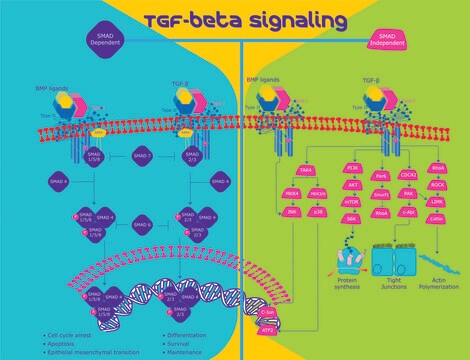Alle Fotos(1)
Wichtige Dokumente
L3408
Transforming Growth Factor-β1 Latency Associated Peptide human
≥97% (SDS-PAGE), recombinant, expressed in Sf21 cells, lyophilized powder, suitable for cell culture
Synonym(e):
LAP, TGF-β1
Anmeldenzur Ansicht organisationsspezifischer und vertraglich vereinbarter Preise
Alle Fotos(1)
About This Item
Empfohlene Produkte
Biologische Quelle
human
Qualitätsniveau
Rekombinant
expressed in Sf21 cells
Assay
≥97% (SDS-PAGE)
Form
lyophilized powder
Mol-Gew.
protein 70 kDa
Methode(n)
cell culture | mammalian: suitable
Verunreinigungen
endotoxin, tested
Eignung
suitable for molecular biology
UniProt-Hinterlegungsnummer
Lagertemp.
−20°C
Angaben zum Gen
human ... TGFB1(7040)
Allgemeine Beschreibung
Research Area: Cell Signaling
TGF-β is released from degranulating platelets and secreted from nearly all cells in a biologically inactive complex which is unable to bind to cellular receptors and is not recognized by antibodies to TGF-β. The peptide can be activated by acidification, alkalinization, or action of chaotropic agents in vitro. The complex consists of TGF-β associated non-covalently with a protein designated as the latency associated peptide (LAP). TGF-β and LAP represent components of a pro-peptide that is cleaved in a post-golgi compartment prior to secretion. The recombinant human LAP is produced from a DNA sequence corresponding to the 278 amino acid residues of pre-pro-TGF-β1 terminating prior to the mature TGF-β1. LAP contains a Cys33 to Ser33 substitution. LAP contains 249 amino acids, generated after cleavage of a 29 amino acid residue signal peptide. LAP is a glycoslyated, disulfide linked homodimer.
TGF-β is released from degranulating platelets and secreted from nearly all cells in a biologically inactive complex which is unable to bind to cellular receptors and is not recognized by antibodies to TGF-β. The peptide can be activated by acidification, alkalinization, or action of chaotropic agents in vitro. The complex consists of TGF-β associated non-covalently with a protein designated as the latency associated peptide (LAP). TGF-β and LAP represent components of a pro-peptide that is cleaved in a post-golgi compartment prior to secretion. The recombinant human LAP is produced from a DNA sequence corresponding to the 278 amino acid residues of pre-pro-TGF-β1 terminating prior to the mature TGF-β1. LAP contains a Cys33 to Ser33 substitution. LAP contains 249 amino acids, generated after cleavage of a 29 amino acid residue signal peptide. LAP is a glycoslyated, disulfide linked homodimer.
Anwendung
Latency Associated Peptide (LAP) may be used to inhibit transforming growth factor-β 1 activity in various biological systems.
Transforming Growth Factor-β1 Latency Associated Peptide human has been used to coat the cell culture inserts for cell migration assays to determine the functional effects of impeding αvβ6 endocytosis in vitro. It has also been used to coat non-tissue culture-treated 96-well plates for adhesion assays.
Biochem./physiol. Wirkung
Latency Associated Peptide (LAP) binds transforming growth factor-beta 1 (TGF-β1) to form a latent complex. The activity of TGF-β1 is primarily regulated through the activation of the latent molecule. LAP has the ability to stimulate epithelial cell migration, representing a new function for LAP in controlling monocyte trafficking and immune modulation. Following post-translational modification, TGF-β1 binds non-covalently to the LAP to establish latency. Due to its crucial function in modulating TGF-β1 activity, LAP plays a fundamental role in governing a range of TGF-β1 effects. LAP is expressed on immature dendritic cells and contributes to T cell differentiation. LAP exhibits both chemotactic and anti-inflammatory activity independently of active TGF-β1.
TGF-β1 is produced by many cell types, but is reported to be most concentrated in mammalian platelets, where it is present at approximately four times the level of TGF-β2.
TGF-β1 is produced by many cell types, but is reported to be most concentrated in mammalian platelets.
Physikalische Form
Lyophilized from 0.2 μm filtered phosphate buffered saline containing 1.25 mg bovine serum albumin.
Hinweis zur Analyse
The biological activity is measured by its ability to inhibit TGF-β1 activity on mouse HT-2 cells.
Haftungsausschluss
Unless otherwise stated in our catalog or other company documentation accompanying the product(s), our products are intended for research use only and are not to be used for any other purpose, which includes but is not limited to, unauthorized commercial uses, in vitro diagnostic uses, ex vivo or in vivo therapeutic uses or any type of consumption or application to humans or animals.
Lagerklassenschlüssel
11 - Combustible Solids
WGK
WGK 3
Flammpunkt (°F)
Not applicable
Flammpunkt (°C)
Not applicable
Persönliche Schutzausrüstung
Eyeshields, Gloves, type N95 (US)
Hier finden Sie alle aktuellen Versionen:
Besitzen Sie dieses Produkt bereits?
In der Dokumentenbibliothek finden Sie die Dokumentation zu den Produkten, die Sie kürzlich erworben haben.
Muge Sarper et al.
Breast cancer research : BCR, 19(1), 33-33 (2017-03-24)
Normal myoepithelial cells (MECs) play an important tumour-suppressor role in the breast but display an altered phenotype in ductal carcinoma in situ (DCIS), gaining tumour-promoter functions. Matrix metalloproteinase-8 (MMP-8) is expressed by normal MECs but is lost in DCIS. This
Unser Team von Wissenschaftlern verfügt über Erfahrung in allen Forschungsbereichen einschließlich Life Science, Materialwissenschaften, chemischer Synthese, Chromatographie, Analytik und vielen mehr..
Setzen Sie sich mit dem technischen Dienst in Verbindung.




